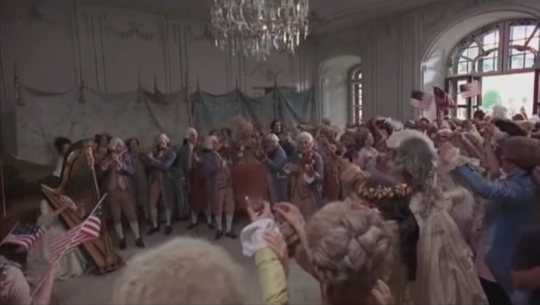
The Liberty Song
Come, join hand in hand, brave Americans all,
And rouse your bold hearts at fair Liberty’s call;
No tyrannous acts shall suppress your just claim,
Or stain with dishonor America’s name.
In Freedom we’re born and in Freedom we’ll live.
Our purses are ready. Steady, friends, steady;
Not as slaves, but as Freemen our money we’ll give.
Our worthy forefathers, let’s give them a cheer,
To climates unknown did courageously steer;
Thro’ oceans to deserts for Freedom they came,
And dying, bequeath’d us their freedom and fame.
In Freedom we’re born and in Freedom we’ll live.
Our purses are ready. Steady, friends, steady;
Not as slaves, but as Freemen our money we’ll give.
The tree their own hands had to Liberty rear’d,
They lived to behold growing strong and revered;
With transport they cried, Now our wishes we gain,
For our children shall gather the fruits of our pain.
In Freedom we’re born and in Freedom we’ll live.
Our purses are ready. Steady, friends, steady;
Not as slaves, but as Freemen our money we’ll give.
Then join hand in hand, brave Americans all,
By uniting we stand, by dividing we fall;
In so righteous a cause let us hope to succeed,
For heaven approves of each generous deed.
In Freedom we’re born and in Freedom we’ll live.
Our purses are ready. Steady, friends, steady;
Not as slaves, but as Freemen our money we’ll give.
In Freedom we’re born and in Freedom we’ll live.
Our purses are ready. Steady, friends, steady;
Not as slaves, but as Freemen our money we’ll give.
Not quite as poplar as “Yankee Doodle” – and likely not at the top of your list of favorite patriotic songs, but “The Liberty Song” was certainly popular during the Revolutionary War.
Written in 1768 by John Dickinson, the Liberty Song was set to the British Navy tune “Heart of Oak.”
But it was hardly a noble British song. In fact, Dickinson “set out to reflect on the political strife caused by the Townshend Acts of 1767, the latest in a series of British crown taxes levied on the Colonies” (Source).
The song also commented on John Hancock’s ship the Liberty. The Liberty had been seized for smuggling. “This seizure, along with anger over the acts, precipitated riots and led to the declaration of a suspension of English imports by Boston merchants in August 1768, to begin December 31” (Source).
John Dickinson, a political activist, had become something of a triple threat – even before publishing his song. He was a successful lawyer, a businessman, a militia officer in the Revolutionary War, a member of both the First and the Second Continental Congresses, one of the primary drafters of the Articles of Confederation, a delegate to the Constitutional Convention of 1787, as well as the stated president of both Delaware (1781) and Pennsylvania (1782). Dickinson was also “known as the ‘Penman of the Revolution’ for his ‘Letters from a Farmer in Pennsylvania,’” an extremely popular political (Source).
“The Liberty Song” first appeared in the Pennsylvania Journal on July 7, 1768, and 9 other prominent publications throughout July. Then, on September 5, 1768, it also appeared in the Boston Chronicle.
From the beginning, it was widely popular, “sung throughout the colonies at political meetings, dinners, and celebrations” (Source). It united the Colonists as they confronted the many new laws placed upon them by England. Likewise, it, like “Yankee Doodle” became a popular anthem throughout the Revolution.
A year after it’s publication, (August 14, 1769) John Adams recorded in his diary that he and some other 350 Sons of Liberty sang The Liberty Song “at a Dorchester tavern where Dickinson’s younger brother was a guest of honor” (Source). In fact, in the mini-series John Adams, John Adams, Benjamin Franklin, and others can be seen singing this popular song of the era at a spectacularly flamboyant party while the two were visitors to France.
[Below: The Liberty Song in John Adams]

[iframe src=”” width=”700″ height=”500″ scrolling=”auto” ]
